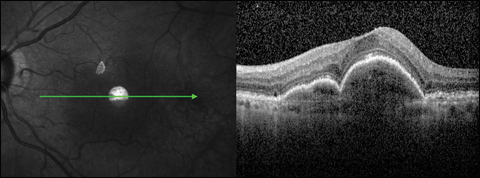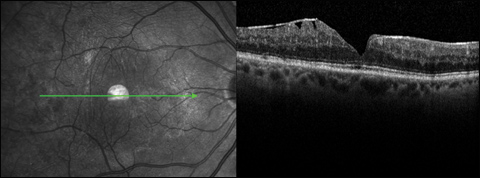OCT screening before cataract surgery: Three must-know diseases
Subtle macular changes may not be seen on clinical examination, so a high-resolution view of the retina before phaco can help set patients' postop expectations.
With the advent of OCT, we can examine the retina, particularly the macula, in high resolution before cataract surgery. This is important because the cataract may not be the sole cause of visual impairment, and patients need to have appropriate expectations set before cataract surgery.
OCT makes it easy to identify subtle macular changes that may not be apparent when the fundus is examined clinically. Using the principle of optical interferometry, these devices acquire sharp, high-resolution views of the retina even when there is dense media opacity.
There are three must-know retinal conditions that should be identified before planning phacoemulsification surgery. As a cataract surgeon, to keep abreast of the advances in retinal imaging, I rely on sites such as EyeGuru.org, which has provided the cases featured below.
No. 1: Macular degeneration
Consider the following case (Figure 1): Our patient arrives for preoperative evaluation with 20/80 best corrected vision that does not improve with pinhole. He has a visually significant cataract with moderate nuclear sclerosis and an unremarkable fundus exam with a somewhat hazy view of the retina. Cataract surgery is recommended, which he undergoes without complication. Postoperatively, he achieves 20/40 best corrected vision. At this point, careful macular exam shows subtle pigmentary changes and some drusen. OCT shows a fibrovascular pigment epithelial detachment without retinal edema, which accounted for his suboptimal visual outcome.
Patients with macular degeneration, whether the dry or wet form, can have an insidious course of disease without the classic presentation of metamorphopsia and blurry vision. Even dry macular degeneration can be associated with localized dysfunction of the retinal photoreceptors and can account for several lines of vision loss. Paracentral focal areas of atrophy can be difficult to discern in a blonde fundus. These changes can easily be overlooked, and the visual decline may be inappropriately attributed to the cataract. It may be beneficial to perform an OCT if there is any doubt of drusen or pigmentary changes or if the view from the cataract is sufficiently poor to preclude fine macular exam.

Images: EyeGuru.org


No. 2: Epiretinal membrane
Epiretinal membrane (ERM) is a relatively common entity with an incidence of about 7% in the general population. It can be a subtle macular finding that is easily missed on routine exam. Again, this is a chronic, insidious disease that can account for mild to even severe vision loss. Patients can have asymmetric disease with one eye much worse than the other. ERMs can be associated with visual distortion, cystoid macular edema, reduced contrast sensitivity and even lamellar retinal holes.
Even if the ERM is deemed to be mild, these patients are at a higher risk for postoperative cystoid macular edema even if the cataract surgery itself is perfectly performed. These patients are also less-than-ideal candidates for a multifocal IOL or those using diffractive rings to elongate the depth of focus. An acrylic monofocal IOL may be a wise choice in these patients, particularly if there is a chance that the patient will need a future pars plana vitrectomy.
In another case (Figure 2), the patient was found to have 20/30 best corrected vision after cataract extraction with significant metamorphopsia. He was subsequently referred to a retina specialist who performed vitrectomy and membrane peeling. Because ERM is a surgical disease, preoperative cataract planning should make provisions for staged surgical repair with a vitreoretinal surgeon.
No. 3: Vitreomacular traction
The age range for development of posterior vitreous separation and cataract overlap. A portion of these patients develop vitreomacular traction (VMT), which can be completely funduscopically occult. It is caused by a mismatch in timing between liquefaction of the vitreous jelly and separation of the vitreous face from the retina. Because cataract surgery itself can be associated with posterior vitreous detachment, this disease is important to identify before taking your patient to the operating room (Figure 3). Remember that with cataract surgery we are removing a cataract that is about 4 mm thick and replacing it with an IOL that is approximately 1 mm thin. This means that we can expect the vitreous to shift in the postop period. There are different ways to address VMT, including vitrectomy and enzymatic vitreolysis, and patients can have an excellent visual outcome after treatment.
The strength of OCT testing is that while the above three diseases are subtle on clinical exam, they are all quite obvious on the OCT image. Your patient is going to be greatly benefited by cataract surgery, but it is important to set postoperative expectations in light of these concurrent diseases. It is far better to refer patients for evaluation by a retina specialist before their cataract operation than rushing them to seek treatment secondarily. Remember the saying that if you predict a problem ahead of time, you are seen as the sharp expert; if you only recognize the problem after it has occurred, you are likely to be blamed for causing it.
- For more information:
- Uday Devgan, MD, is in private practice at Devgan Eye Surgery, Chief of Ophthalmology at Olive View UCLA Medical Center and Clinical Professor of Ophthalmology at the Jules Stein Eye Institute, UCLA School of Medicine. He can be reached at 11600 Wilshire Blvd. #200, Los Angeles, CA 90025; email: devgan@gmail.com; website: www.DevganEye.com.
Disclosure: Devgan reports he personally uses EyeGuru.org for his own education but has no commercial or financial ties to that entity. Devgan acknowledges David Xu, MD, and Shawn Lin, MD, creators of EyeGuru.org.
